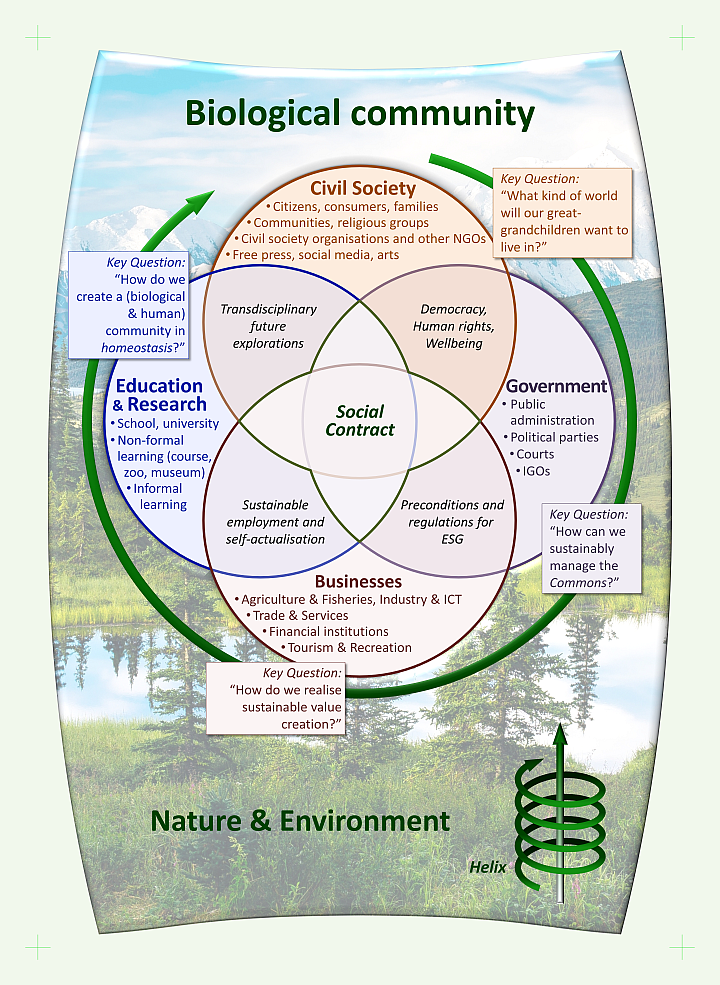Abstracts by chapter |
Summaries of the twelve chapters of Fundamentals of Sustainable Development, edition 2025.
Part 1: Sustainable Development, the voyage of discovery of the twenty-first century
Chapter 1. The Adventure: New paradigms
The opening chapter introduces the four parts the book consists of, providing an overview of the topics that will be discussed in detail in the subsequent chapters.
The chapter emphasizes the urgent need for profound changes to achieve sustainability, highlighting the rapid, unbalanced, and life-threatening trends affecting humanity and nature. It calls for a new mindset to adapt to fast-changing global conditions, using the "Peak meat" case study to illustrate the unsustainability of current livestock practices and the rise of plant-based and cultured meat alternatives.
It stresses the importance of having a future vision and understanding global interdependence, introducing the ecological footprint concept to show how human activities exceed Earth's capacity. The chapter acknowledges that major transitions, such as shifting to renewable energy and a circular economy, are complex and create both winners and losers.
A key theme is the need for paradigm shifts, moving from control over nature to adaptation and recognizing the interconnectedness of sustainability issues. The chapter underscores the necessity of innovative, systemic thinking to address environmental and social challenges and achieve a sustainable future.
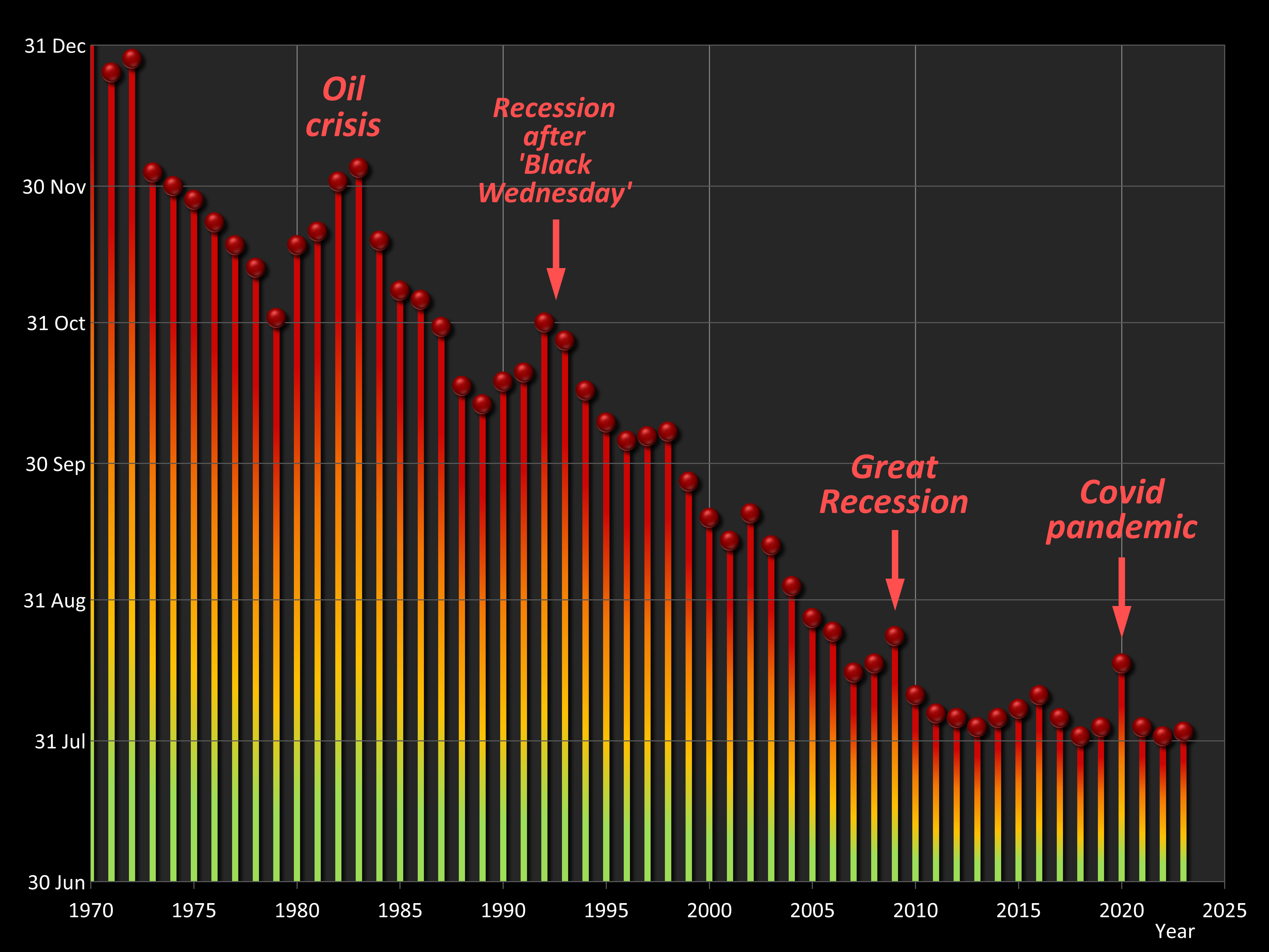
Figure 1.3: Earth Overshoot Day
Chapter 2. The Complexity: People, Planet and Profit
The concept of sustainable development emerged to address interconnected global issues like poverty, hunger, and environmental degradation. Recognizing that isolated solutions were ineffective, the 1987 Brundtland Report introduced sustainable development, defined as development that meets present needs without compromising future generations' ability to meet theirs.
Sustainable development can be described with the "Triple P" framework: People (social sustainability), Planet (ecological sustainability), and Profit (economic sustainability). This framework underscores the importance of balancing human rights, environmental conservation, and economic stability.
Positive feedback occurs when an effect reinforces its cause, creating a self-reinforcing loop. For example, soil depletion leads to deforestation, which further degrades soil fertility. Negative feedback, on the other hand, occurs when an effect counteracts its cause, promoting stability. For instance, awareness of soil erosion can lead to sustainable farming practices, reducing further degradation.
The Tragedy of the Commons illustrates how individual users acting in their own interest can deplete a shared resource, harming the collective good. Garrett Hardin's 1968 concept explains that when common resources like groundwater or grazing land are overused, the resource eventually becomes unsustainable, leading to collective loss despite short-term individual gains.
Chapter 3. The Urgency: Climate change has started
Climate change poses a significant threat to global natural, social, economic and political systems, underscoring the urgency of sustainable development. Temperature rise is approaching the critical 1.5°C above pre-industrial levels due to the anthropogenic greenhouse effect.
Positive feedbacks, such as the ice-albedo effect, amplify warming. Melting polar ice reduces the Earth's reflectance, leading to more heat absorption. A 1.5°C increase has serious consequences, such as extreme weather, disrupted jet streams and unpredictable monsoons. Arctic warming exacerbates these effects, causing severe storms, prolonged droughts and devastating floods.
Tipping points in the global system create additional unpredictable and potentially catastrophic risks, highlighting the need for immediate and sustained global action.
Mitigation includes reducing or preventing greenhouse gas emissions, such as transitioning to renewable energy sources, improving energy efficiency, reforestation and perhaps geoengineering. This requires simultaneous economic and political strategies, including emissions trading and international cooperation such as the Paris Agreement and the EU Green Deal. If that does not succeed sufficiently, then going to court can help compulsorily, as some successful cases prove.
In addition, adaptation is indispensable, adapting to climate impacts through measures such as building resilient infrastructure, developing drought-resistant crops and improving water management.
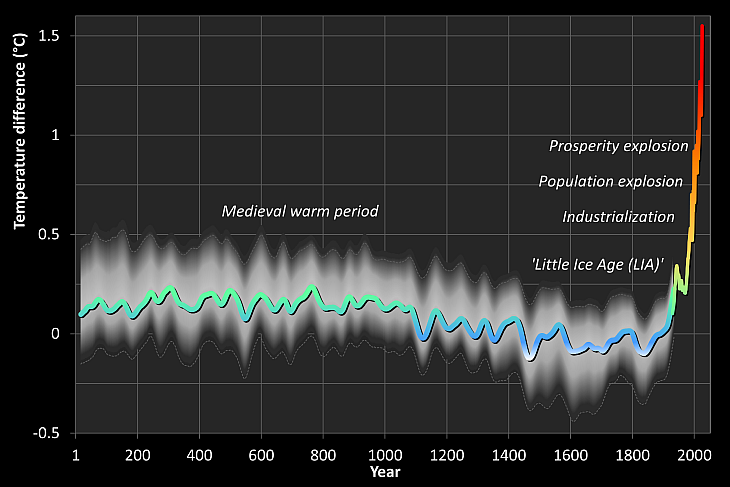
Top half of figure 3.1: Temperature change since year 1
Part 2: Zooming out to global society
Chapter 4. Now, soon and later: Thinking from visions of the future
As a tool for the exploration of the future, four growth models are introduced: exponential (uninhibited) growth, logistic (inhibited) growth, weakly inhibited growth leading to overshoot and rebound, and collapse scenarios. These models illustrate different patterns of growth and their potential consequences.
The text delves into scenarios, emphasizing the importance of envisioning various future possibilities to guide current actions. It references the Club of Rome, known for its "Limits to Growth" report, which modeled the interplay of global factors affecting sustainability. The concept of backcasting is discussed, advocating for planning backward from a desired future, a ‘Utopia’, to create effective strategies.
The Millennium Ecosystem Assessment is described, introducing the concept of ecosystem services, and highlighting the critical state of the world's ecosystems and the need for sustainable management. The notion of deep time is introduced, urging consideration of long-term impacts beyond immediate concerns. Responsibility is emphasized, particularly in recognizing the broad scope and extended period of consequences resulting from today's decisions.
The chapter concludes with the "Guideline for a Good Decision," which stresses informed and responsible decision-making to ensure sustainable outcomes. This includes considering the full consequence scope and consequence period to navigate towards a sustainable future effectively.
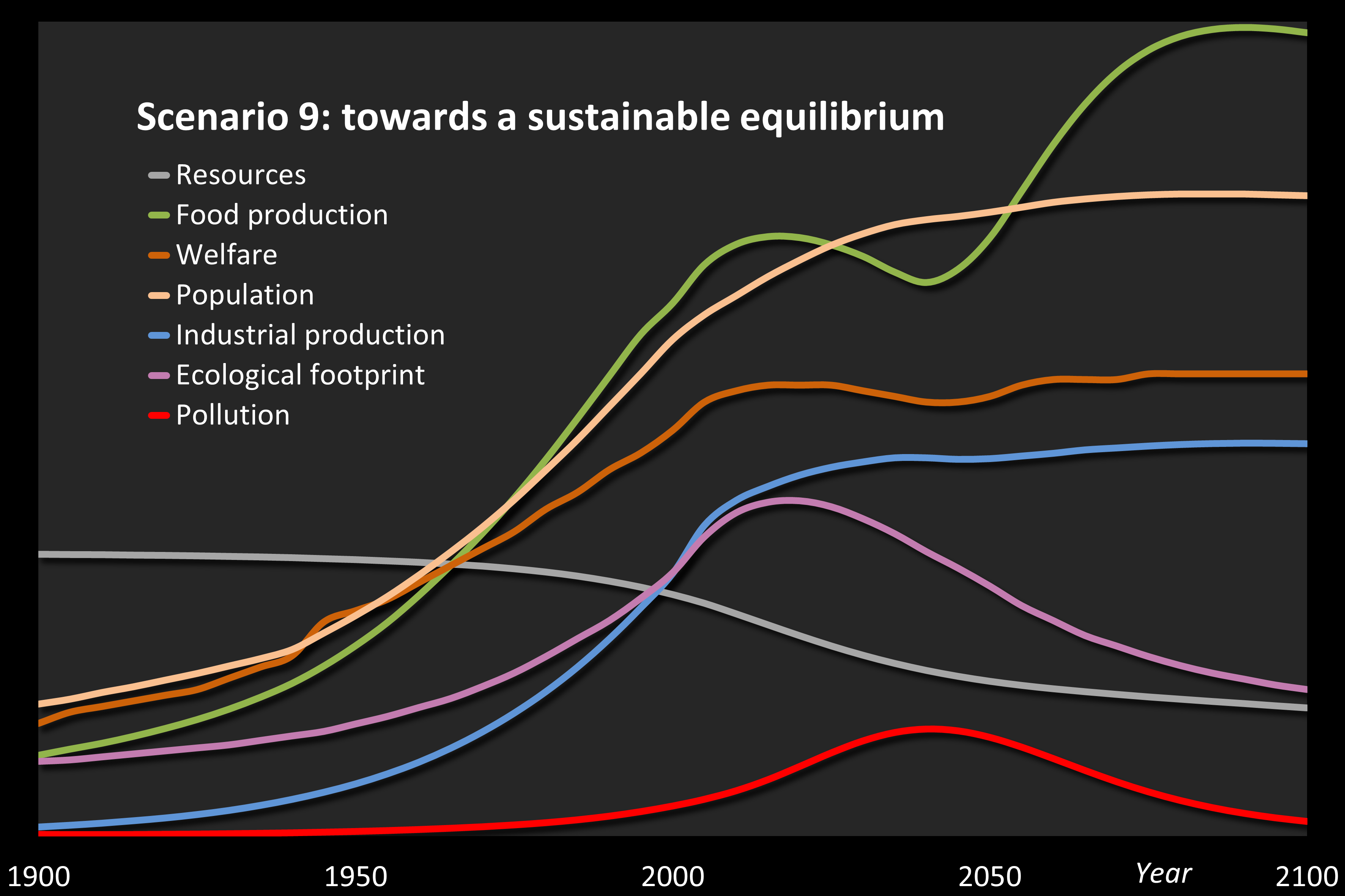
Bottom half of figure 4.8: Scenario 9 of the Club of Rome model, which leads to sustainability
Chapter 5. Here, there and far away: Global entanglement
The historical origins of today's interconnected global society are explored, starting with the major transitions from the Renaissance through the Enlightenment and the rise of the nation-state. The Renaissance (late 13th to end 16th centuries) spurred free thought and scientific inquiry, exemplified by figures like Leonardo da Vinci and Copernicus. This era saw the beginning of European colonization and the brutal transatlantic slave trade. The Enlightenment (17th and 18th centuries) challenged the authority of the Church and monarchs, fostering ideas about human rights and governance. Thinkers like Hobbes, Locke, and Kant laid the groundwork for modern democracy and the concept of an international legal order.
During the Scramble for Africa in the 19th century, European powers colonized and shamelessly exploited the African continent, resulting in economic and social impacts that still impact today’s world. It examines the rise of nation-states and the decolonization movements of the 19th and 20th centuries, highlighting the complex legacy of colonial borders and conflicts.
Everything has grown larger, except for humans. Issues like refugees, migration, and poverty are explored, emphasizing the dehumanization that often accompanies these challenges. The chapter stresses the importance of human rights in addressing these issues, reflecting on their historical context to understand the responsibility of wealthy nations for a more equitable global society.
Chapter 6. Agenda 2030: Global Goals
The Sustainable Development Goals (SDGs) are described in detail, established in 2015 for a 15-year term to address global challenges such as poverty, climate action, and partnerships. An overview is shown of the seventeen goals, their targets and indictors.
A key SDG is Goal 1, which aims to eradicate poverty. The definition of poverty is ambiguous, with the World Bank's thresholds being criticized for being too low. The current extreme poverty line is PPP$ 2.15 per day, which many experts argue should be higher to reflect a realistic minimum for basic nutrition, life expectancy and wellbeing.
SDG 17 partly focuses on partnerships between rich and poor countries. Effective partnerships require thorough financial reforms, leadership of international organizations from poor countries, debt relief, and development projects led by poor countries, exemplified by the African Great Green Wall initiative.
Further strengths and weaknesses of the SDGs are discussed, resulting from controversies and compromises, related to e.g. inclusiveness, child marriage, war and peace, economic growth. The text highlights the interconnected nature of the SDGs, where progress in one area can impact others, sometimes negatively. For instance, protecting tropical forests may hinder local agricultural improvements, illustrating the difficulty in balancing conflicting interests.
Chapter 7. Agenda 2100: Global transition
The dynamics of improvements, innovations, and transitions within systems are explored, using various historical and futuristic examples to illustrate paradigm shifts and profound system change. It explains that transitions involve unexpected consequences and extensive redesigns based on new thinking. Past transitions, like the agricultural revolution, the Industrial Revolution, and the shift from colonialism to international collaboration, are highlighted as examples.
The chapter addresses the energy transition in Europe, aiming for climate neutrality by 2050 through mitigation and adaptation strategies. This is a part of the EU Green Deal, which exists of many simultaneous and coupled transitions, including the agriculture and food transition ‘Farm to Fork’.
As an example of an adaptation strategy, the development of floating cities is discussed, adapting to rising sea levels. Experiments are underway globally, including Oceanix City in South Korea, aiming to house thousands of people on floating platforms. This paradigm shift moves from traditional fixed, heavy buildings to light, flexible, and floating structures, potentially leading to widespread adoption and the redefinition of urban living.
Transitions cannot be managed as if they were projects. Transition management emphasizes the integration of top-down and bottom-up approaches. Successful transitions often involve cooperation between various actors across different scales, combining international, governmental, and private efforts in a process of co-evolution.
Part 3: Zooming in on Planet, Profit, People
Chapter 8. Planet: Living with nature
The IUCN Red List is explained, which tracks species at risk of extinction, and the Sixth Extinction is described, an ongoing event characterized by the rapid and severe loss of species due to human activities.
Newly introduced in this book is the ‘Nature Restoration Agenda’, consisting of fifteen elements, aiming to safeguard and rehabilitate natural environments. This agenda stresses the importance of generating and disseminating knowledge, revising human-nature relationships, and applying the precautionary principle, which advises taking preventive action in the face of uncertainty to avoid harm to the environment and human health. Necessary preconditions are, as the ‘Agenda’ formulates, saving the climate and achieving peace and prosperity for all. Legally, the concept of ‘ecocide’ should be introduced internationally.
Based on thorough scientific research, ecosystem services are described, which proves that many ecological system boundaries are structurally violated. This needs to be restored in order to avoid disaster. There are two approaches to improve the ecologic efficiency. One is, to adapt more to nature, e.g. in the form of permaculture. The opposite approach applies technology, e.g. based on genetically modified organisms or vertical farming. Globally sufficient solutions may consist of a balance between the two approaches.
The chapter closes with sustainable fisheries, followed by the introduction of the water footprint, describing the use of clean water.

Figure 8.4: The efficiency of the conversion of plant to animal food for humans
Chapter 9. Profit: Sustainable business
Consistently closing material cycles, based on reuse and recycling, and making use of methods like life cycle assessment, LCA, leads to a circular economy. Redesign is particularly highlighted as essential for designing products that are easier to disassemble and recycle. Calculating prices of products and services throughout their lifecycles, in which all externalities are integrated, leads to ‘true prices’.
Wherever values are discussed, most of the time this is interpreted as economic or financial value, based on their utility value for humans, making use of monetisation and commodification, and ignoring other, often even more important values such as emotional, scientific or intrinsic value.
The apparent necessity of continuous economic growth is set against the scientifically proven necessity of ending material growth and returning to within ecological system boundaries. A discussion is going on about whether the two can be combined through dematerialisation and decoupling.
Next, ESG is described: environmental, social, governance. Several approaches are presented, illustrated with cases of ESG oriented companies, based on e.g. B Corps, Global Compact, the SDGs, GRI, and the World Business Council for Sustainable Development. On the other hand, cases are presented in which companies largely ignore sustainability and act irresponsibly. In order to set sustainable boundaries to their operations, the importance is discussed of international organisations such as the UN and the EU.
Part 4: Professional and personal action perspectives
Chapter 11. Thinking differently: Who owns the Earth?
Humanity expanded globally, claiming property and asserting territorial rights, rooted in narratives of legitimacy by philosophers like John Locke. After World War II, human influence on the environment surged dramatically through the ‘Great Acceleration’, marking the onset of the Anthropocene, an era where human activity shapes the planet.
Human impact is driven by the narratives and policies derived from the words we possess. The Four Spheres model – Logosphere, Mythosphere, Politosphere, and Phenosphere – illustrates how words shape narratives, which in turn influence policies and result in tangible effects. Misused or incorrect words lead to harmful policies and unsustainable outcomes, emphasizing the need for a fundamental shift in our language and thinking to achieve sustainability.
Anthropocentrism has been challenged by scientific discoveries. Astronomy, geology, biology and other disciplines have shown that humans are a recent addition to an ancient and vast universe and are members of the natural family tree, with strong emotional and cognitive similarities of humans with other animals, debunking speciesist views and advocating for a more integrated and responsible approach to our role on Earth.
One essential precondition is the adoption of ‘peace’, replacing the earlier paradigm of ‘warmongering heroism’. Rather than absence of war, peace is primarily a state of mind, not only related to humans and their nations, but also with nature, as is illustrated with a quote from the Earth Charter.
Chapter 12. You, human
Current attempts to realise sustainability, including the SDGs, are short-term related, aiming at ‘glued-on sustainability’, where profound system changes don’t occur. Opposing this, ‘intrinsic sustainability’ is introduced, requiring ‘dreams’, i.e. a clear vision of a desired future. A proposal for a set of ‘Intrinsic Sustainability Goals’ (ISGs) is offered.
Evolution towards intrinsic sustainability requires a ‘learning society’ in order to cure our present world, suffers from the ‘polycrisis’: a syndrome of interconnected global crises, including ‘fever’ (global warming), ‘psychosis’ (loss of reality due to misinformation and pseudoscience), ‘addiction’ (to money, social media, buying stuff, etc.) and more. The good news is that we possess many ‘medicines’, together forming an ‘action perspective’, allowing every individual and institution to take part in sustainable action.
‘Sustainably competent professionals’ possess a range of competences for sustainable development, as described in the RESFIA+D model, which allows readers to assess their own competence levels and ambitions. Such an insight and plan may lead to self-actualisation, where ‘dragons of inaction’ are overcome, striving for ‘inner development goals’ based on dreams and ‘strategic idealism’. This is reinforced by making a Pledge, which ends with: ‘I understand that there will be times in the course of my career when it will be difficult to do what I am now promising to do. I will adhere to this pledge, even in those times.’
The entire Pledge is available at https://niko.roorda.nu/pledge.
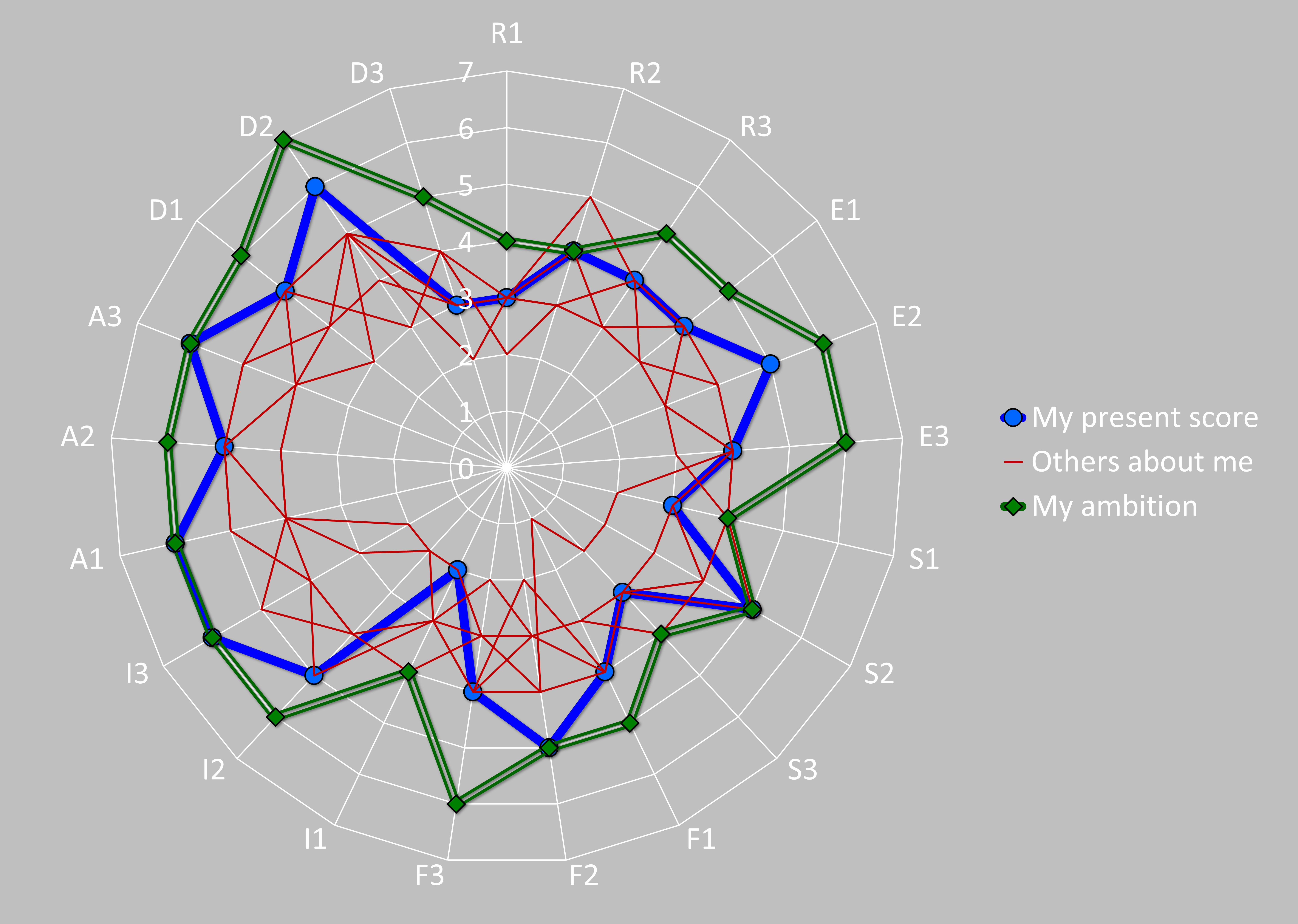
Figure 12.5: A result of a RESFIA+D assessment, showing competences for sustainability of a student or a professional


